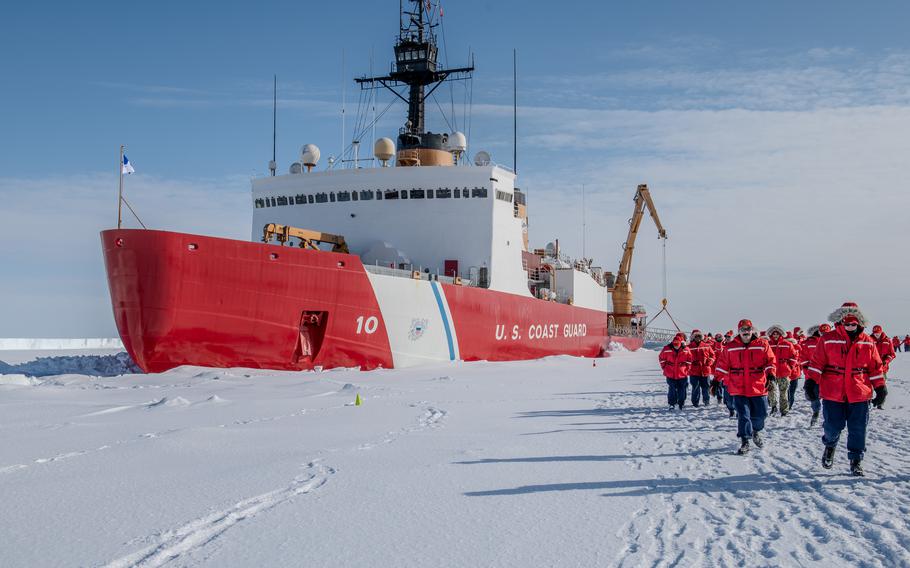
The Coast Guard operates just two icebreakers, including the 48-year-old heavy icebreaker Polar Star. (Ryan Graves/U.S. Coast Guard)
A House panel on Wednesday leveled bipartisan criticism at the Coast Guard for delays in building Polar Security cutters needed to offset the growing Russian and Chinese activity in the Arctic.
U.S. Rep. Carlos Gimenez, R-Fla., chair of the House Homeland Security Subcommittee on Transportation and Maritime Security, said he called the hearing in the final days of the current session of Congress to underline the urgency in the face of ramped-up joint military operations by Russia and China in the region.
“We are reviewing the progress — or lack thereof — of the Coast Guard’s Polar Security Cutter program,” Gimenez said.
Climate change has opened sea lanes in the polar region during the summer months, with Russia and China recently operating joint naval exercises around the Bering Sea near Alaska.
The Coast Guard has reported that Russia has 55 icebreakers, including seven heavy icebreakers capable of slicing through ice up to 2 meters in thickness. Some of the icebreakers are nuclear-powered, allowing them to operate without refueling.
China has declared itself a “near-Arctic” nation and has fast-tracked icebreaker construction. It has four icebreakers, with a fifth due to launch in 2025. The government of President Xi Jinping has cut the construction time for new icebreakers to 30 months.
The Coast Guard operates just two icebreakers — the 48-year-old heavy icebreaker Polar Star, and the 27-year-old medium icebreaker Healy.
Congress approved $125 million to purchase the only commercially available icebreaker, the 12-year-old Aiviq, which was painted in U.S. Coast Guard colors and intended to be homeported in Juneau, Alaska.
The move was a stopgap measure while the Coast Guard attempted to catch up on its plan to build three new heavy icebreakers, called Polar Security Cutters, six years behind schedule.

U.S. Rep. Carlos Gimenez, R-Fla., and U.S. Rep. Shri Thanedar, D-Mich., at a hearing of the House Homeland Security Committee’s Subcommittee on Transportation and Maritime Security on Wednesday, Dec. 18, 2024. (U.S. House of Representatives)
“While the Coast Guard has thankfully awarded a contract to acquire a commercially available icebreaker, this is only a temporary fix,” Gimenez said.
U.S. Rep. Shri Thanedar, D-Mich., the ranking Democrat on the committee, pointed to a recent Congressional Budget Office report that showed the first Polar Security Cutters was unlikely to start service until 2030. The report put the price of the three-ship plan at $5.1 billion — about 60% more than original estimates.
“There is something terribly wrong here,” he said. “Here we are in 2024, and the Coast Guard is only now starting work on the first new cutter.”
Coast Guard Vice Admiral Thomas Allan, deputy commandant for mission support, said he was not at the hearing to “make excuses.”
Allan was asked if he believed Russia and China have an advantage over the United States in the Artic region because of their icebreaker fleets.
“Yes, I do,” Allan replied.
Allan said the United States had not built a heavy icebreaker in almost 50 years. Expertise in the design and construction of the ships has to be rebuilt. Just as several Navy programs for carriers, submarines, frigates and other ships are behind schedule and over budget, the Coast Guard faces the same challenges of too many vessels vying for work at too few shipyards short of experienced workers.
“I am clear-eyed about the issues,” Allan said.
Gimenez said the delays were still extraordinary.
“It’s been six years since this program was authorized, and we still don’t have a final design,” he said. “It only took us nine years to get to the moon.”
To compensate for the lack of icebreakers, Allan said the Coast Guard plans to increase the number of helicopters and fixed-wing aircraft deployed to the region.
Allan said the Coast Guard needs its budget to grow from $12 billion to $20 billion and have up to nine icebreakers, including at least three capable of cutting through up to two meters of ice.
The number would place the United States behind Russia and China but would be capable of maintaining “sovereignty of our waters,” Allan said.
The United States has entered into an agreement with Canada and Finland to coordinate design expertise and shipyard availability to hasten the overall number of icebreakers that NATO allies can contribute to offset the Russian and Chinese advantages.
The Coast Guard has also delayed a decision on how big an expansion it plans at its base in Seattle until next month. The new cutters would likely be homeported to the facility on Puget Sound and operate in the Arctic and Alaska regions during the warmer summer months.
Gimenez said he planned to revive the debate over the Coast Guard’s handling of the Polar Security Cutter program when President-elect Donald Trump takes office and Congress will have Republican majorities in the Senate and House.
“I don’t think we are delivering the assets that the men and women of the Coast Guard need.”